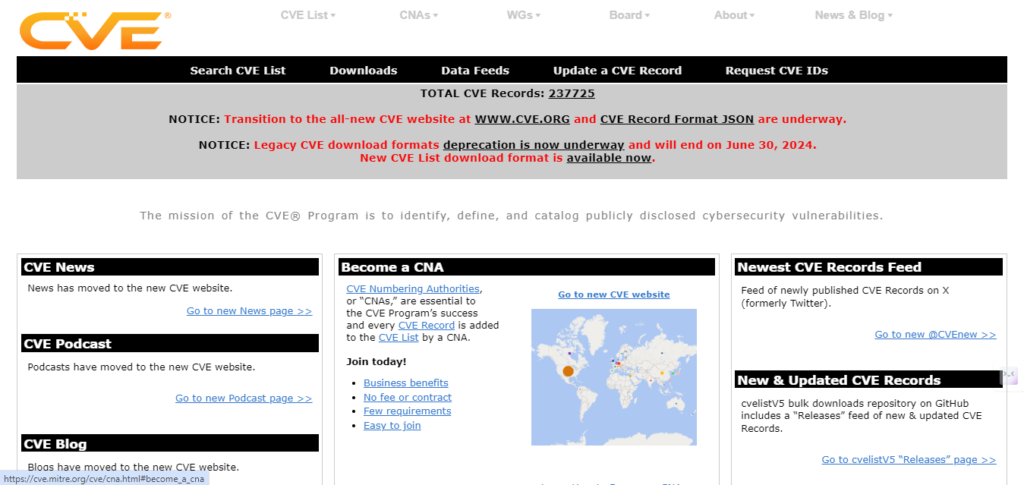Common Vulnerabilities and Exposures (CVE) is a list of publicly disclosed information security vulnerabilities and exposures. Managed by the MITRE Corporation, CVE aims to provide common identifiers for publicly known cybersecurity vulnerabilities to standardize vulnerability management across different organizations and tools.

Key Features of CVE
- Standardization: Each vulnerability or exposure listed in CVE is given a unique identifier known as a CVE ID (e.g., CVE-2024-12345). This standardization helps different security products and services to identify and address the same issue consistently.
- Descriptive Information: Each CVE ID is accompanied by a brief description of the vulnerability, often including:
- The affected software or hardware.
- The type of vulnerability (e.g., buffer overflow, SQL injection).
- Potential impacts (e.g., remote code execution, data breach).
- Reference Links: CVE entries often include links to further information, such as vendor advisories, patches, and other relevant documents.
- Public Access: The CVE list is publicly available and can be accessed by anyone, ensuring transparency and wide availability of information regarding security vulnerabilities.
How CVE Works
- Submission: When a vulnerability is discovered, researchers or vendors can submit it to CVE Numbering Authorities (CNAs). CNAs are organizations authorized to assign CVE IDs.
- Validation and Assignment: The CNA reviews the submission to ensure it meets the criteria for inclusion. If accepted, a CVE ID is assigned, and the entry is added to the CVE list.
- Publication: The newly assigned CVE ID, along with its description and references, is made publicly available in the CVE list.
Usage of CVE
- Security Professionals: Use CVE IDs to track vulnerabilities in the software they manage.
- Developers: Use CVE information to understand and fix vulnerabilities in their code.
- Organizations: Implement CVE-based vulnerability management processes, ensuring they track and mitigate known vulnerabilities.
- Security Tools: Many security scanning tools and vulnerability management systems rely on CVE identifiers to provide consistent and standardized reports.
CVE and Related Standards
- National Vulnerability Database (NVD): Managed by NIST, this database incorporates CVE identifiers and provides additional analysis, including CVSS scores, which indicate the severity of vulnerabilities.
- Security Content Automation Protocol (SCAP): A suite of specifications for standardising the format and nomenclature of security-related information, which includes CVE.
Example of a CVE Entry
CVE-2024-12345
Description: A buffer overflow vulnerability was discovered in XYZ software version 1.2.3, allowing remote attackers to execute arbitrary code via a crafted payload.
References:
– Vendor Advisory: [link_to_advisory]
– Patch: [link_to_patch]
– Additional Analysis: [link_to_analysis]
Benefits of Using CVE
- Improved Communication: Having a standardized identifier helps various stakeholders (security teams, vendors, software developers) communicate clearly about specific vulnerabilities.
- Streamlined Processes: Facilitates the automation of vulnerability management processes and integration within security tools.
- Enhanced Security Posture: By being aware of known vulnerabilities and their details, organizations can prioritize and address security issues more effectively.
Conclusion
The Common Vulnerabilities and Exposures (CVE) system provides a standardized and accessible way to identify and describe cybersecurity vulnerabilities. By assigning unique identifiers to each vulnerability, CVE enhances communication, coordination, and efficiency in the security community. This facilitates more effective vulnerability management and helps organizations improve their overall security posture. The widespread adoption of CVE underscores its importance in maintaining a robust and transparent approach to cybersecurity.
Discover more from Upcoming Hackers
Subscribe to get the latest posts sent to your email.